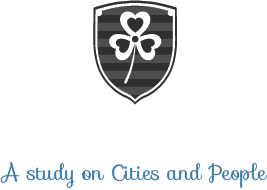How big is the active city center in a medium sized city?
Using Google Map’s ‘Area of Interest’
The active city center is the part of a city’s’ downtown where there is continuous commercial opportunities and people activity (see my definition here). The active city center is a spatial concept and can thus to an extent be measured in size. I’m curious to find out how big the general active city center is in medium sized cities in Europe, and whether one can predict their size or whether there are differences in size between countries. In this article I will make use of Google Maps’ Area of Interest (AoI), which according to Google is an algorithmic process that allows for highlighting of areas with the highest concentration of restaurants, bars and shops. The specific algorithm and its parameters are unknown to me.
During my time traveling and counting people in my projects 1, 2 and 3 I found that I could make very good use of Googles AoI to help me define the active city center in 19 European cities. The layer do not identify the active city center according to my definition in 2, but if i had to guess it does correlate to about 90-95%. Together with a cross-reference with Open Street Map’s commercial information, this layer is as good and objective I can get if I want to compare the 788 medium sized cities that i have investigated in this project.

The above map shows Googles’ algorithm for ‘Area of Interest’ in black. This area, according to my own observations of 19 European cities, closely resembles my definition of the Active City Center, but does not do so to 100% as seen by the red areas. I’m only aware of the red parts because I’ve been to the city myself, so in order to keep the comparison standardized, I will only take into account Googles’ Area of Interest. I will only include Areas of Interest that are at minimum 600 meters (comfortable walking distance) apart. Using these guidelines I investigated 788 medium sized cities (about 80.000-200.000 population) in 40 countries and divided the area by the city population. This gave me a value of how much m² of AoI each inhabitant have, as can be seen in the map below:

Now, this map is interesting but very problematic. Since I can only guarantee some form of correlation between Googles AoI and my own Active city center in a European context, other countries in the world are more problematic. Iran has plenty of cities with likely high amount of commercial activity, but its cities are usually very car-centric (often you’ll even find a high traffic roundabout in the very city center). Given the heat of the country and its traditional bazaars, much of the commercial activities seem to be in covered bazaars, and not primarily on the streets or along plazas. It’s also hard to know whether Google’s information is reliable as it probably do not take into account informal shops or street vendors. Tunisian and Algerian cities have a similar problem to Iran, even though their city centers are much more walkable. The dense Medinas in Tunisia and Algeria is also missing polygons on Google Maps, which in turn messes up the AoI coloring and thus makes it impossible to measure its area correctly. Israeli and Lebanese cities resembles European cities more that the other investigated Middle Eastern cities. Mexican and Latin American cities also closely resembles European cities in that they have plazas, parks and a mainly outdoors commercial culture. Latin American cities also get quite good values according to this method. Canadian and US cities are not reliable to compare to European cities in this manner. Their plentiful and large surface parkings in their downtowns are counted as AoI and enlarges their “Active City Centers” unfairly – There are some exceptions to this, like Boulder, Colorado. The cities in Australia and New Zealand are similar to European cities. In the below map I show the median value of AoI m²/person per country/state:

Due to the more problematic nature of comparing European cities to other continents I will from here on only refer to European cities (and Turkey). Let’s dive into Europe and look at the countries more closely. The below map shows the average AoI m²/person per country. The higher the value the more Area of Interest in the city center per person.

The surprisingly vast difference between Belgium and The Netherlands is a bit more easily understandable due to the Belgian city of Tourcoing being a high value outlier; generally Belgium and The Netherlands are more similar and this will be taken into account in the upcoming map. Before we move on analyzing this map, we’ll have to take a closer look at Germany, as there seem to be big differences between the cities in northern Germany and the ones in southern Germany:


With the values found in this investigation we can begin to answer the question posed: “How big is the active city center in a medium sized city?”. Looking at the above maps we can see that different countries plays by different rules in terms of their population to AoI ratio. In an attempt to categorize the countries based on their common AoI values that they could compare themselves to within their “region”, I created the below map showing the general AoI per person per region. Northern European cities seem to value around the 1.5-2.5 AoI m²/person. Another common region can be found in parts of the southern part of Europe, where values tend to range between 2.5-3.0 AoI m²/person. A central European belt (along with Spain) show the highest values, generally having between 3.0-5.0 AoI m²/person. The balkans along with parts of the baltics have generally smaller values ranging from 1.0-1.6 AoI m²/person. The lowest values can be found in eastern Europe where the values generally range from 0.4-0.8 AoI m²/person. Now, keep in mind that these are the average values of the regions, and there are outlier cities with both lower and higher values.

Having answered the question as to the general size of the active city centers in medium sized cities in Europe, I also tried to investigate whether it’s possible to predict the AoI of a city based on the city’s’ population. By running the data from all 338 European cities (Russia, Moldova and Ukraine excluded due to very low values), i found a weak correlation of 0.16 between population size and the size of the AoI. If i were to include the eastern region this correlation would be even lower. This would suggest to me that it would be a quite senseless endeavour to try to predict the AoI solely based on population size – hence, cities are a bit more complex than this. I wanted to investigate the relationship a little bit further still by grouping differently sized cities into two brackets; a lower tier with cities that have a population of 80.000-140.000, and a higher tier with cities that have a population of 140.000-200.000. I then compared the different brackets to their AoI size and found that indeed, cities with higher population do generally have larger AoI. For example, German high tier cities have an AoI that is about 48 000 m² larger than the low tier cities – while Polish high tier cities have a whopping 145 000 m² advantage compared to the country’s’ low tier cities.

So… While we cannot predict an exact AoI value based on the population size of a city, we can still confidently assume that larger cities have larger Areas of Interest (or Active city center).
Now that we’ve answered the question by making use of Google Map’s Area of Interest, i’ll end with some fast trivia based on my data:
Top 10 cities AoI m²/person:
6.8 – Toledo, Spain
6.7 – Lecce, Italy
6.5 – Alessandria, Italy
6.4 – Pescara, Italy
6.0 – Bergamo, Italy
6.0 – Lleida, Spain
5.9 – Palencia, Spain
5.7 – Mechelen, Belgium
5.5 – Caceres, Spain
5.4 – Arezzo, Italy
Italian and Spanish cities are clearly dominating the top list, as expected. Mechelen in Belgium is an interesting exception.
Bottom 10 cities AoI m²/person:
0.03 – Alchevsk, Ukraine
0.1 – Nazran, Russia
0.1 – Novy Urengoy, Russia
0.1 – Almetyevsk, Russia
0.1 – Salavat, Russia
0.2 – Ukhta, Russia
0.3 – Buzuluk, Russia
0.3 – Uman, Ukraine
0.3 – Novotroitsk, Russia
0.4 – Sarov, Russia
Some cities have a value of 0, i omitted these from this ‘bottom list’. As expected from the maps before, Russia and Ukraine have the smallest AoI m²/person in Europe. One can only imagine what would happen to the local economy of these cities were they designed differently…
Disclaimer: Keep in mind that this data is problematic due to the unknown algorithms of Google Maps and the differences in how different countries count city populations.

